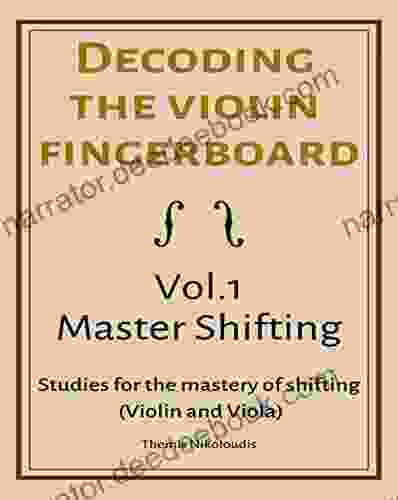Decoding the Violin Fingerboard: Mastering Shifting for Sophisticated Performance

The violin fingerboard serves as a canvas upon which melodies and harmonies are painted with the stroke of a bow. Shifting, a technique that involves moving the fingers up or down the fingerboard to access different notes, is akin to the brushstrokes that bring the musical masterpiece to life. Mastering shifting is paramount for violinists to unlock the full expressive potential of their instrument.
Shifting entails transitioning from one position on the fingerboard to another to play notes that are not within the reach of a single hand position. It allows violinists to play notes across the entire register of the instrument, from the lowest to the highest.
Violinists typically play in three main hand positions:
4 out of 5
| Language | : | English |
| File size | : | 4922 KB |
| Screen Reader | : | Supported |
| Print length | : | 57 pages |
| Lending | : | Enabled |
- First Position: Fingers 1, 2, 3, and 4 cover the first four notes (G, A, B, C) on each string.
- Third Position: Fingers 1, 2, 3, and 4 cover the third, fourth, fifth, and sixth notes (D, E, F#, G) on each string.
- Fifth Position: Fingers 1, 2, 3, and 4 cover the fifth, sixth, seventh, and eighth notes (A, B, C#, D) on each string.
There are two main types of shifts:
- Upward Shifts: Moving towards the bridge of the violin, reaching for higher notes.
- Downward Shifts: Moving towards the scroll of the violin, reaching for lower notes.
Mastering shifting requires coordination between the left hand, which moves on the fingerboard, and the right hand, which guides the bow.
- Prepare: Slightly lift the fingers involved in the shift.
- Slide: Gently slide the fingers to the desired position, maintaining firm contact with the fingerboard.
- Reset: Plant the fingers firmly in the new position, ensuring intonation and clear articulation.
- Maintain Pressure: The bow should maintain consistent pressure throughout the shift.
- Adjust Angle: The angle of the bow may need to be slightly adjusted to accommodate the change in finger position.
- Coordinate Timing: The bow change should be timed precisely with the left hand shift.
Begin by practicing shifts with specific fingerings. Focus on transitioning smoothly between first and third positions, then gradually incorporate higher positions.
Scales and exercises specifically designed for shifting help develop muscle memory and coordination. Start with simple scales and gradually increase the complexity.
Initially, practice shifts slowly, focusing on accuracy and smooth transitions. Gradually increase the speed as proficiency improves.
Pay attention to the sound of your playing. Adjust finger placement and bow technique to achieve clear intonation and a balanced tone.
Shifting is essential for playing double stops (playing two notes simultaneously) and chords. Practice these techniques to enhance your musicality.
Mastering shifting allows violinists to express musical phrases with greater nuance and expression. Use shifts to create accents, enhance dynamics, and convey emotions.
Precise intonation is crucial for effective shifting. Practice with a tuner or in a group setting to ensure accuracy.
Mastering shifting requires consistent practice and effort. While the initial learning curve can vary, with regular practice, significant improvement can be achieved within a few months to a few years.
Shifting can initially present challenges, particularly in achieving smooth transitions and maintaining intonation. However, with dedicated practice and guidance, most violinists can develop proficiency in this technique.
Mastering shifting enables violinists to access the full range of notes on the instrument, play intricate passages, and express musical phrases with greater depth and nuance.
Shifting is an indispensable technique for violinists, unlocking a world of musical possibilities. By understanding the mechanics, practicing with diligence, and incorporating advanced techniques, violinists can master this skill and elevate their performances to new heights. Through the mastery of shifting, the violin fingerboard transforms into a canvas upon which musical masterpieces come alive.
4 out of 5
| Language | : | English |
| File size | : | 4922 KB |
| Screen Reader | : | Supported |
| Print length | : | 57 pages |
| Lending | : | Enabled |
Do you want to contribute by writing guest posts on this blog?
Please contact us and send us a resume of previous articles that you have written.
 Story
Story Reader
Reader Magazine
Magazine Newspaper
Newspaper Sentence
Sentence Bookmark
Bookmark Shelf
Shelf Glossary
Glossary Bibliography
Bibliography Foreword
Foreword Synopsis
Synopsis Footnote
Footnote Manuscript
Manuscript Scroll
Scroll Codex
Codex Tome
Tome Bestseller
Bestseller Classics
Classics Library card
Library card Narrative
Narrative Biography
Biography Reference
Reference Dictionary
Dictionary Thesaurus
Thesaurus Narrator
Narrator Character
Character Resolution
Resolution Card Catalog
Card Catalog Borrowing
Borrowing Periodicals
Periodicals Research
Research Scholarly
Scholarly Rare Books
Rare Books Special Collections
Special Collections Interlibrary
Interlibrary Literacy
Literacy Study Group
Study Group Awards
Awards Reading List
Reading List Book Club
Book Club Carmine Appice
Carmine Appice Jhumpa Lahiri
Jhumpa Lahiri Rae B Lake
Rae B Lake Massimo Polidoro
Massimo Polidoro Beverly Falk
Beverly Falk Izzy Bayliss
Izzy Bayliss Mike Curato
Mike Curato Daniel Tatarsky
Daniel Tatarsky Harrison Weir
Harrison Weir Bill Farr
Bill Farr Rainer Brosch
Rainer Brosch Shep Hyken
Shep Hyken Patrick R Dempsey
Patrick R Dempsey Rebecca Dowd Geoffroy Schwinden
Rebecca Dowd Geoffroy Schwinden Paul Larney
Paul Larney Roland Wanner
Roland Wanner Lloyd Sachs
Lloyd Sachs Judith Loske
Judith Loske Kay Whitlock
Kay Whitlock William N Walker
William N Walker
Light bulbAdvertise smarter! Our strategic ad space ensures maximum exposure. Reserve your spot today!

 J.D. SalingerThe Enigmatic Isis Orb: A Journey into Xanthian Lore from Piers Anthony's...
J.D. SalingerThe Enigmatic Isis Orb: A Journey into Xanthian Lore from Piers Anthony's... Kenneth ParkerFollow ·14.8k
Kenneth ParkerFollow ·14.8k Ernest HemingwayFollow ·8.3k
Ernest HemingwayFollow ·8.3k Dwight BellFollow ·17.3k
Dwight BellFollow ·17.3k Edmund HayesFollow ·19.2k
Edmund HayesFollow ·19.2k Hugo CoxFollow ·13.4k
Hugo CoxFollow ·13.4k Lucas ReedFollow ·12.6k
Lucas ReedFollow ·12.6k Jamie BellFollow ·19k
Jamie BellFollow ·19k Emanuel BellFollow ·11.8k
Emanuel BellFollow ·11.8k

 Abe Mitchell
Abe MitchellUnveiling the Urban Cheating Rich System: A Comprehensive...
In today's complex and ever-evolving urban...

 Preston Simmons
Preston SimmonsSelection, Processing, and Care of Reeds: A Comprehensive...
Reeds are essential...

 Rob Foster
Rob FosterKeeper of the Grail: The Youngest Templar
Prologue: A Sacred...
4 out of 5
| Language | : | English |
| File size | : | 4922 KB |
| Screen Reader | : | Supported |
| Print length | : | 57 pages |
| Lending | : | Enabled |
















